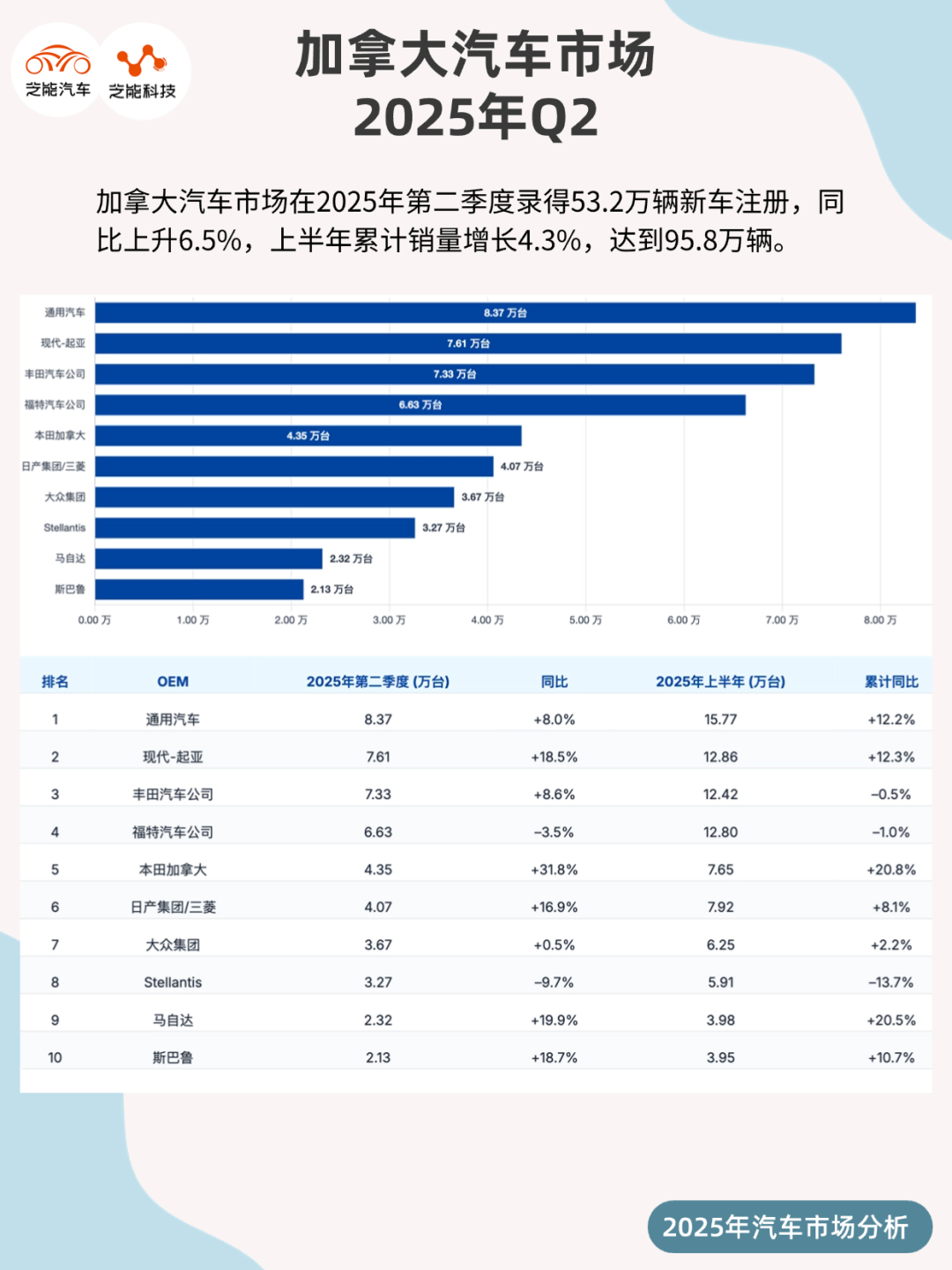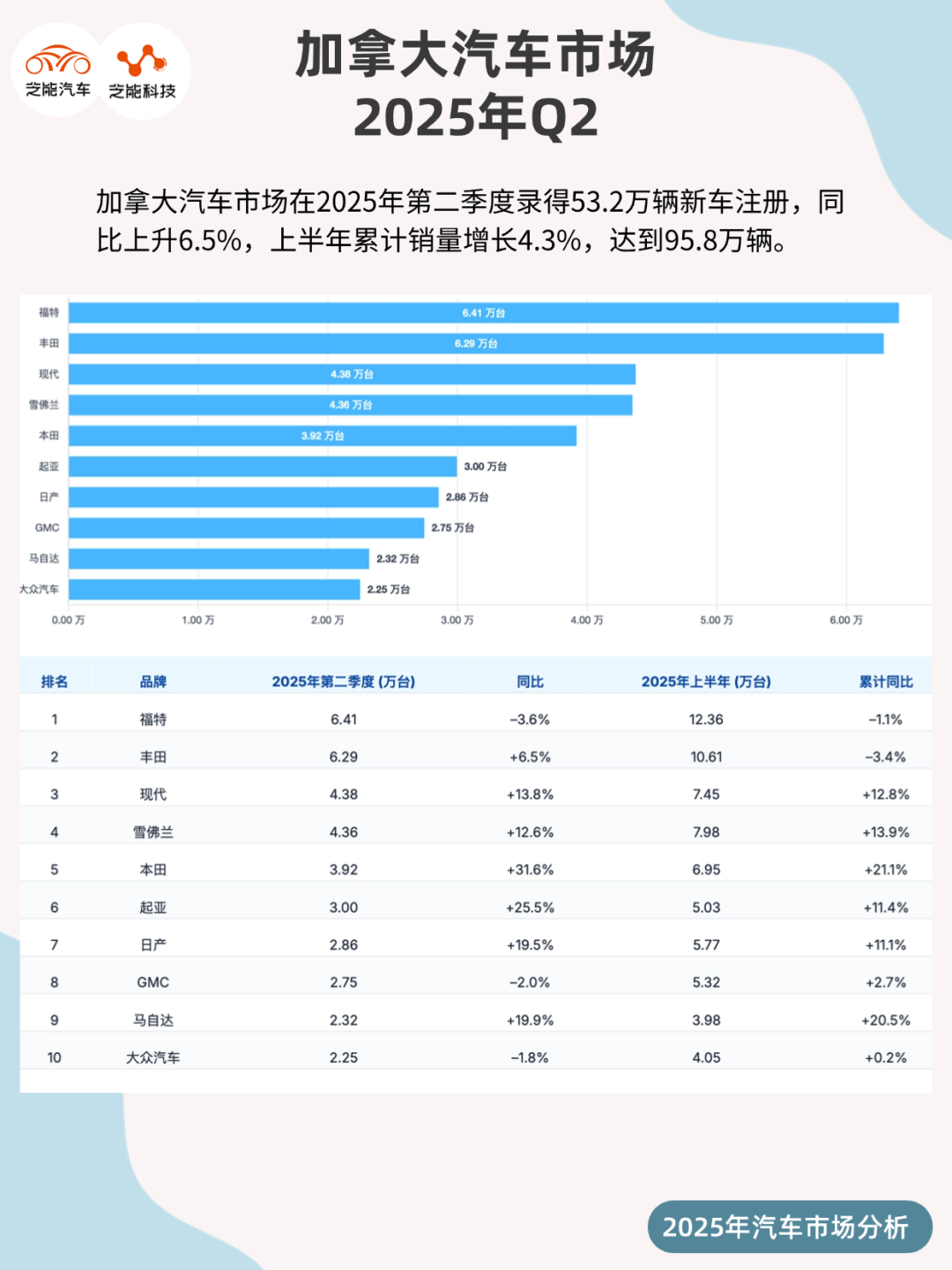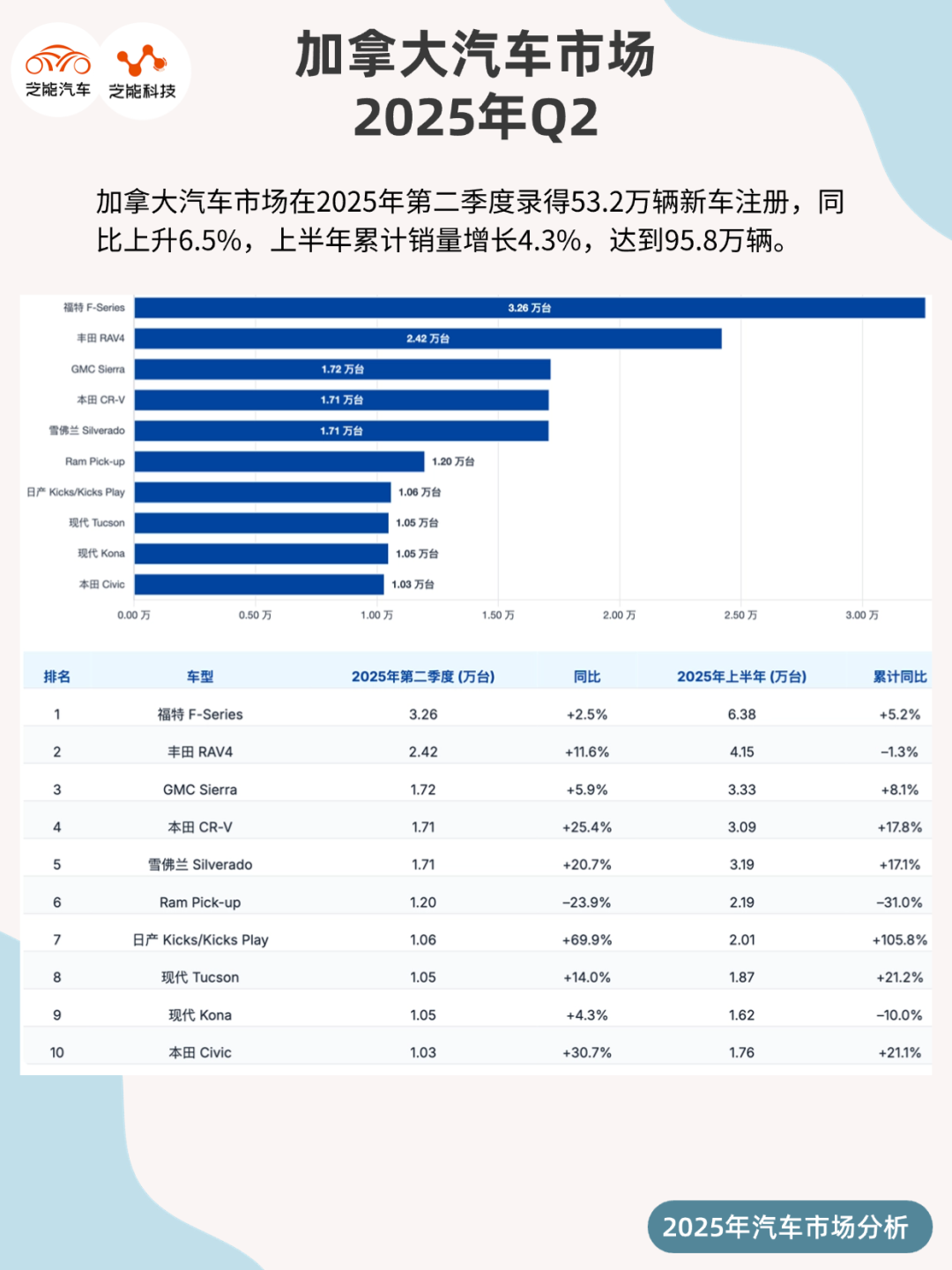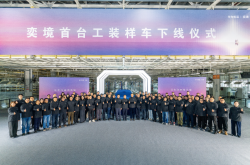American Auto Market | Canada Q2 2025: Tesla Sales Plunge 75%
![]() 07/21 2025
07/21 2025
![]() 604
604

In the second quarter of 2025, Canada's light vehicle market expanded by 6.5% year-on-year, yet this growth was accompanied by significant brand differentiation.
Traditional Japanese brands such as Honda, Kia, and Nissan saw robust comebacks with substantial increases, whereas Tesla experienced a dramatic decline, with quarterly sales plummeting by nearly 75% year-on-year.
Amidst a modest overall market recovery, brand performance disparities have intensified, reflecting the profound impact of consumer preferences, brand strategies, and product update cycles.
01 Structural Differentiation Amid Growth: Japanese Rebound and EV Decline
In Q2 2025, Canada's light vehicle market registered 532,000 new vehicle registrations, marking a 6.5% year-on-year increase. This quarterly growth was solid but based on a relatively low base in the same period of 2024, making the overall rebound moderate.
More strikingly, major manufacturers exhibited notable market performance differentiation, particularly the sharp contrast between the strong rebound of Japanese brands and the steep decline of some electric vehicle brands.

◎ Honda Canada sold 43,529 vehicles in the quarter, up 31.8% year-on-year, making it the mainstream manufacturer with the strongest growth. Its CR-V sales surged 25.4%, ranking fourth in model sales after General Motors' Sierra and Chevrolet Silverado.
◎ The Civic continued to be Canada's best-selling traditional sedan, with a year-on-year increase of over 30%.
◎ Kia refreshed its market presence in Canada with a 25.5% growth rate, and multiple new models like the K4, Sorento, and Niro achieved significant growth.
◎ Nissan and Mitsubishi also recorded a 16.9% increase, reflecting Japanese brands' overall advantages in product cycle updates, SUV market layout, and reliability reputation.
◎ Toyota, despite a relatively modest increase of 8.6%, remained highly competitive due to stable sales of best-selling models like the RAV4 and Corolla, ranking second in Q2 sales after General Motors and the Hyundai-Kia Group.

In contrast, the electric vehicle sector faced significant challenges.
◎ Tesla's Q2 sales are estimated at only 4,500 vehicles, a year-on-year drop of 74.5%, causing its ranking to fall from 13th last year to 22nd on the brand chart. Model Y sales declined by over 76% year-on-year, and Model 3 fell out of the top ranks.
This decline not only reflects consumers' concerns about price fluctuations, range anxiety, and subsidy uncertainties in the electric vehicle market but also highlights Tesla's shortcomings in product updates and local market adaptation.
◎ In contrast, General Motors, Kia, and Toyota's hybrid and plug-in hybrid models continued to gain popularity, gradually encroaching on the space previously occupied by pure electric vehicles.
02 Market Concentration Changes and Brand Strategy Competition
From the overall automaker landscape:
◎ General Motors maintained its market leadership with an 8% year-on-year sales increase.
◎ The Hyundai-Kia Group achieved significant growth of 18.5%, surpassing Ford and Toyota to rank second, driven by Kia's strong performance and the stable sales of Hyundai Tucson and Elantra. This marks the rise of Korean cars from the periphery to the mainstream, fueled by product design and cost-effectiveness.
◎ Ford faced considerable pressure, with overall sales declining by 3.5%. At the model level, the F-Series remained the sales champion, but its growth rate of 2.5% lagged behind the overall market.
SUV models like the Escape and Explorer also underperformed, reflecting the gradual loss of marginal growth advantages for traditional pickup trucks and SUVs in North America.

◎ Stellantis (formerly Fiat Chrysler Automobiles) was one of the worst-performing traditional manufacturers, with sales down 9.7% year-on-year. Its Ram pickup truck sales fell 23.9%, dropping to sixth place on the sales chart, reflecting eroded competitiveness in core segments.
◎ In contrast, although the Chrysler brand had a low overall base, it achieved over 40% brand growth driven by a substantial rebound in the Pacifica model (+95.7%), demonstrating the strong pull of individual products.
◎ Among luxury brands, Mercedes-Benz, Lexus, Acura, Audi, and others outperformed the market, with growth rates ranging from 15% to 40%. Notably, Acura quickly boosted sales after the launch of the new-generation RDX and the integration of Honda's electrification strategy.
◎ Meanwhile, traditional premium brands such as BMW maintained modest growth. In contrast, brands like Volvo, Jaguar, and Alfa Romeo struggled with relatively weak growth due to limited product lines and a lack of new models.
In terms of model structure, SUVs continued to dominate the market, with seven out of the top ten best-selling models being SUVs or crossovers.
◎ Nissan Kicks jumped to seventh place, with a year-on-year increase of nearly 70%, showcasing the vitality of the small SUV segment.
◎ Additionally, Kia's newly launched K4 and Sorento also made it into the list of hot-selling models, further consolidating its position in the family car market.
◎ Midsize sedans like the Toyota Camry, Hyundai Elantra, and Honda Civic still had a presence, but most showed weak growth or declines, indicating a continued shift in consumer preferences towards high-riding models.
Summary
In Q2 2025, the modest growth in Canada's auto market concealed profound structural changes. In the competition between traditional fuel vehicles and electric vehicles, consumer attitudes are becoming more rational, and the electric vehicle market is undergoing a reshuffle as the initial boom fades. Tesla's steep decline serves as a cautionary tale.





